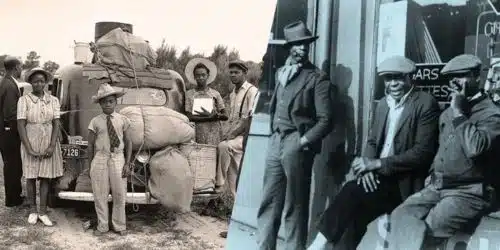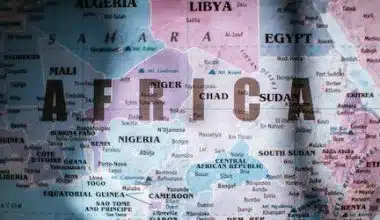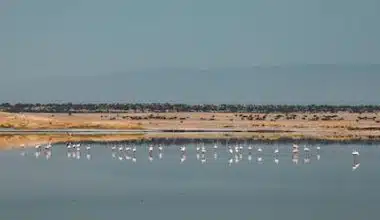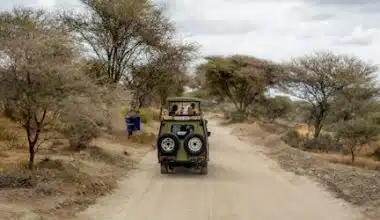One of the biggest population shifts in US history was the Great Migration. Between the 1910s and the 1970s, an estimated six million black Americans relocated from the southern to the northern, midwestern, and western regions. The mass movement’s main goals were to break free from Jim Crow oppression, pursue economic and educational possibilities, and flee acts of racial violence.
The United States’ involvement in and impact from both World Wars are commonly used to divide the Great Migration into two stages. Black Southerners moved to northern and midwestern cities, such as Pittsburgh, Chicago, Detroit, and New York, during the First Great Migration (1910–1940).
More physically fit men were sent to fight in Europe when the war effort intensified in 1917, which left their industrial employment unfilled. A decrease in immigration from Europe and ongoing prohibitions on people of color from other regions of the world put additional strain on the labor supply. Because of all of this, black people now have more access to labor in non-agricultural businesses.
What is the Great Migration?
In American history, the Great Migration refers to the large-scale movement of African Americans from rural communities in the South to major cities in the North and West throughout the 20th century. The bulk of black Americans at the turn of the 20th century resided in the southern states. It is believed that over six million black Southerners moved to metropolitan areas in the North and West between 1916 and 1970 as part of the Great Migration.
After immigration reform in the 1920s, the enormous wave of European emigration to the United States that had started in the late 19th century and was cut off after World War I was reduced to a trickle. The urban industry consequently experienced a labor shortage. Especially during World Wars II and III, when the defense industry required more unskilled labor, a significant internal migration of African Americans filled these shortages. Despite slowing down during the Great Depression, migration rates increased significantly for several decades following World War II, when the Great Migration resumed.
What Caused the Great Migration?
Racial inequality continued throughout the South in the 1870s following the Civil War and the Reconstruction era, and the segregationist laws known as “Jim Crow” quickly established the state constitution.
Due to black codes and the sharecropping system, which provided little in the way of economic opportunities, black Southerners were still compelled to earn a livelihood by working the land. This was especially true following crop destruction due to a local boll weevil infestation in the 1890s and early 1900s.
Although the Ku Klux Klan was formally disbanded in 1869, it persisted in its clandestine activities, and in the Jim Crow South, black Southerners were often the targets of assault, intimidation, and lynching.
When was the Great Migration?
Industrialized cities in the North, Midwest, and West experienced a labor crisis when World War I broke out in 1914 because the war halted the continuous flow of European immigrants to the United States.
To the dismay of white Southerners, recruiters lured African Americans north as war production ramped up. Black newspapers, especially the widely read Chicago Defender, featured advertisements and first-hand testimonials of achievement praising the prospects found in the North and West cities.
One million black individuals are thought to have left the South by the end of 1919, according to some academics. Most of them traveled by bus, train, or boat; a lesser percentage used cars or even horse-drawn carriages.
Major Northern cities saw significant increases in the black population between 1910 and 1920, including New York City (66 percent), Chicago (148 percent), Philadelphia (500 percent), and Detroit (611 percent).
Numerous immigrants obtained employment in foundries, factories, and slaughterhouses, where they faced difficult and occasionally hazardous working conditions. Due to their difficulty finding employment, female migrants engaged in fierce rivalry for domestic labor opportunities.
Black Migration to the South Compared to White Migration
For black migrants, the South holds greater allure than for white migrants. From 2015 to 2020, Figure 4 displays the regional destinations of interstate migrants who are black and white and who originate from each non-southern region. The South is an important destination for both groups in each of their respective origin regions. However, black immigrants are more likely than white immigrants to choose locations in the South in each scenario.
Less than two-fifths of white migrants and over half of black migrants from the Northeast chose to settle in the South. Compared to black migrants, who chose a southern state at a rate of 43%, white migrants in the Midwest preferred to settle in neighboring Midwest states (39%) as opposed to the South (35%). Furthermore, just 28% of white interstate migrants in the West chose to travel to the South, whereas 47% of black migrants did so.
Impact of the Great Migration
Tensions over housing led many citizens to form their communities inside large cities, which aided in the development of a new urban black culture.
The most well-known example was Harlem in New York City, which was originally exclusively a white area but had some 200,000 black residents by the 1920s.
A major issue of the creative movement known as the New Negro Movement and thereafter the Harlem Renaissance, which had a significant influence on the era’s culture, was the black experience during the Great Migration.
The Great Migration also ushered in a period of heightened political involvement with African Americans, who, having lost their rights in the South, now sought a new home in the North and West cities. This activism had a direct positive impact on the civil rights struggle.
The New Great Migration’s Impact on the South
Over the past 50 years, the reversal of black migration has increased the population in southern urban areas. The most notable example of this shift is the five-fold rise in the black population in metropolitan Atlanta between 1970 and 2020. Atlanta was home to the 13th largest black population in the country in 1970, but by 2010, it had slightly surpassed Chicago to take second place in terms of black population size (behind New York). Its black population now makes up 40% more than Chicago’s.
Atlanta has dominated black immigration to urban areas for the past forty years. Possibly the New South’s capital, the city is home to numerous corporate headquarters, a wide range of industries, and educational institutions, in addition to being a major transit hub. It has generally, and particularly for black Americans, been a magnet for migration.
Africa’s Great Migration
The yearly Great Migration in Africa is an unparalleled wildlife encounter and one of the world’s most iconic wildlife events. Every year, millions of antelope species, including zebras and wildebeests, embark on an amazing trek across Tanzania and Kenya, where they must contend with crocodile-infested waterways and terrestrial predators like lions and leopards.
Being present for such an occasion at the site of humankind’s origins is an emotional experience that words and images can never properly express. The Great Migration occurs in some of the world’s most biologically diverse natural regions, which adds to the richness of the experience.
One of the things on everyone’s bucket list for globetrotting is something we all hope to do at some point in our lives. Here is a quick summary of the location, the time, and the reasons why all nature lovers should go!
The Great Migration of East Africa, which includes millions of species, is the world’s greatest migration of terrestrial mammals. Its region includes the most famous reserve on the continent, Serengeti National Park, as well as some of the most stunning habitats on the planet.
Where to Witness the Great Migration in Africa At Its Finest Other natural phenomena are occurrences that occur in the world, but not like the Great Migration. The precise places and times of the erratic travel are subject to constant change, contingent upon prevailing circumstances.
What determines where and when the herds will be at any given time of year is rain—or the absence of it. The event will take place throughout Tanzania and Kenya, but that much you can be certain of.
However, let’s examine a few of the several national parks and reserves in East Africa that provide the best opportunity to witness this breathtaking spectacle:
#1. Ngorongoro Conservation Area (Tanzania)
Ngorongoro Conservation Area: During calving season, newborn wildebeest and Zebras can be seen in this northern Tanzanian region. Because there are so many juvenile prey, there’s also a likelihood that you’ll see assaults by lions, leopards, and other predators while you’re there.
#2. Serengeti National Park (Tanzania)
Large herds of zebra and wildebeest are starting to assemble here, making it one of the greatest spots to see the Great Migration. The Grumeti River is an intimidating obstacle that the animals must have the bravery to cross.
#3. Mara River (Tanzania and Kenya)
The task that awaits animals that make it across the Grumeti River crossing is now even more difficult. They will be able to reach the lush Maasai Mara grasslands by fording the tumultuous Mara River. However, the risk of crocodile attacks rises significantly here, frequently resulting in extreme fear among the herds.
#4. Maasai Mara National Reserve (Kenya)
Now that they’ve reached these feeding grounds, the animals can put on weight before making their way back to the Ngorongoro to mate. However, they must contend with one of the highest lion concentrations in East Africa. In a few months, the survivors will head south, leaving the large cats behind to protect their home ranges.
Where Does Africa’s Great Migration of Wildebeests Take Place?
During the Great Migration of Africa, millions of wildebeest, zebras, and gazelles travel in a circle around the Serengeti-Masai Mara habitat. The Serengeti-Masai Mara ecosystem, which spans Tanzania and Kenya in Africa, is more than 24,000 km2 in size.
This enormous region encompasses other smaller game reserves, animal conservancies, and private conservation zones in addition to the Serengeti National Park, the Masai Mara National Reserve, and the Ngorongoro Conservation Area.
Even though the wildebeest herds migrate annually as they follow the rains, let’s separate it into the key moments of birth, mating, and river crossings. If you want to make the most of your Great Migration Africa experience, you should be in these locations.
When Is the Ideal Time to Witness the Serengeti Great Migration?
It is a really smart idea to divide the animal migration schedule into manageable portions because it encompasses two countries (Kenya and Tanzania), runs 365 days a year, and involves numerous protected areas.
Tanzania’s Serengeti National Park is a great place to begin. It is enormous, encompassing almost 15,000 km2, or 97% of the Serengeti-Mara habitat. The Serengeti extends north to the Seronera plains, past the Grumeti Game Reserve, and eventually to the Mara River and Kenya’s Masai Mara. To the south, it borders the Ngorongoro Conservation Area and Masawa Game Reserve. Within Tanzania’s Serengeti National Park’s boundaries are arguably the two best locations to witness the Great Wildebeest Migration.
#1. January to March: Southern Serengeti
The Ndutu plains of the Ngorongoro Conservation Area and the broad savannah of the southern Serengeti Park are where the herds of wildebeest, zebra, and antelope start to assemble in January and continue into March. As the ungulates eat, the females start to give birth. Seeing the vast herds of gnus and other antelope on the open plains is a wonderful chance.
#2. August to October: Masai Mara and Mara River Crossing
The best time to try to observe the Mara River crossings is from August to October. It’s amazing to watch the violence and drama near the Mara River. There is confusion as the crowds pulse into the swiftly moving waters and the herds assemble along the banks.
Where is the Great Migration in Africa?
The Great Migration: What Is It? The Great Migration takes place annually in East Africa’s vast grasslands, where millions of wildebeests, Burchell’s zebras, antelopes, and other herd animals travel from Tanzania’s Serengeti to Kenya’s Masai Mara.
Where Did Africans Migrate First?
There exists evidence that suggests modern humans departed from Africa at least 125,000 years ago via two distinct routes: one via the Nile Valley, which led to the Middle East and possibly even into modern-day Israel (Qafzeh, 120,000–100,000 years ago); the other via the Red Sea’s Bab-el-Mandeb Strait.
What Month Is the Great Migration in Africa?
It’s generally agreed that July through November is the optimum period to see the Great Migration. In Kenya’s Maasai Mara, the wildebeest migrate in large numbers during July and August, spanning the Mara River. River crossings are among the Great Migration’s most sought-after experiences for tourists.
Which African Country Has the Highest Migration Rate?
As of 2023, South Sudan was estimated to have the greatest net migration rate in Africa. It had around 20 migrants for every 1,000 residents. This implies that 20 immigrants will move to South Sudan for every 1,000 residents.
What Caused the Great Migration in Africa?
At about 20 per 1000 people, South Sudan is estimated to have had the highest net migration rate in Africa as of 2023.
Summary
During the 20th century, millions of African Americans moved from the rural South to the urban North. This was part of the Great Migration, an event that changed American history. The need to escape racial injustice and the desire for economic opportunity drove this migration, which altered culture and demographics. Significant population transitions occurred in cities like Chicago, Detroit, and New York, which had an impact on social dynamics. It also helped to shape the African-American urban experience.
- KENYA SAFARI TOURS: Best Operators & Packages
- BEST DESTINATIONS FOR VACATION IN AFRICA
- BEST AFRICAN SAFARIS: Top 15 Destinations
- Black Friday Hotel Deals: Save Big on Your Next Vacation
- TRIPS TO AFRICA: The Ultimate Guide






